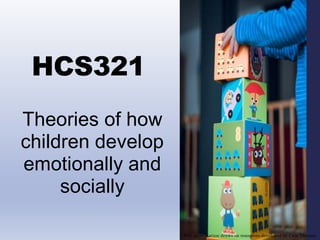
HCS321 201830
- 1. HCS321 Theories of how children develop emotionally and socially This presentation draws on resources developed by Cate Thomas
- 2. Overview Introduction Moving beyond Nature vs. Nurture Cognitive Development Attachment Ecological Systems Theory Early Brain Development
- 3. Introduction Helping or Responding to Children Young People and Families experiencing adversity Whose Rights and Responsibility Protection or Welfare? Why is knowledge of children’s development important?
- 4. Moving beyond Nature vs. Nurture Biology- Genetic Transmission Our DNA is the baseline of who/what we become. Positivist Statistical Generalised Environment- The life lived Our ancestry provides the starting point of how we can become who we want to be. Relativist Interpretive Contextual
- 5. Genetic or Social Influence What is the biological limit of gender? How does different intelligence, sensory capacity, mobility etc constrain development of the person/ When is Race known and understood?
- 6. Theories of Normal Childhood Development
- 7. Cognitive theory Jean Piaget The nature of Intelligence Operative (finding out) and Figurative (making meaning) Assimilation (making new knowledge fit what we know) OR Accommodation (changing what we know to take on new knowledge) Stages and ages (children progress through identifiable stages)
- 8. Piagetian –Developmental Stages •Birth to 2 years (language) •Sub-stages, Reflex, Habits, Coordination, Internalisation Sensorimotor •2 – 7 years •Symbolic Functions (Imagination) and Intuitive Thought (Questioning) Pre- Operational •7 – 11 years •7 logic processes to master •Complexity and externalisation Concrete operational •11- Adulthood •Engaging in the abstract and hypothetical – what can and will be Formal Operational
- 9. Cognitive Theory Lev Vygotsky Contemporary of Piaget, but working in Soviet Russia. ZPD – Zone of Proximal Development Children's development is influenced by their exposure to what others can do, not limited to what they can do. Learning and Intelligence is Culturally informed and prioritised. Children learn what is culturally important for them to know at the earliest possible time.
- 10. Post/neo Piagetians Piaget became strongly criticised for aspects of his methodology. He acknowledge some limits to his original theory but since his death (1980) has regained support from theorists who seek to adjust and improve his theories. Devolving stages to apply in cultural and Domain specific (Math/Art) contexts (Demitriou) Additional Stages or processes in Formal Operational stage (Fischer)
- 11. Attachment theory John Bowlby English psychologist Post WW2 studies of maternal deprivation Influenced by own childhood in upper class English family Challenged dominant psycho-analytic views of children who did not emotionally engage with mothers to consider the mothers actions as well as child’s Researched maternal deprivation for WHO in Europe and recommended, “that young children should have a continuous and positive relationship with their mother, or they may suffer serious permanent mental health issues.” Researched extensively on the impact of grief and loss in children. Became internationally influential on maternal and child public health policy. Criticized by feminist theory for making parenting mother- centric and validating paternalistic views of “good and bad mothering”
- 12. Attachment Theory Mary Ainsworth American/Canadian psychologist Post WW2 studies of Maternal Deprivation on Children Undertook renowned longitudinal ethnographic study of mother-child attachment in Uganda in the 1960’s that identified many cross cultural, linguistic and geographic similarities in mother-child attachment that supported Bowlby’s arguments. Developed the “Strange Situation” Secure/Insecure Attachment Classification procedure: Criticised that this procedure is highly artificial and in some views unethical because it subjects a child (and parent to stress)
- 13. The Strange Situation Procedure •Child with parent in room •Child free to play with any toy of choiceObserve Child’s Exploration •Stranger enters •Parent leaves •Stranger responds behaviourally to child's reactions. Observe Child Reactions to Parent •Parent returns and comforts child •Stranger and parent leave –child aloneObserve Reunion and Departure •Stranger re-enters and responds behaviourally to the childObserve Childs Reactions to Stranger •Parent re-enters room, picks up child and engages with them •Stranger leaves. Observe Childs response to Reunion
- 14. The Ainsworth Classification Child/Parent Secure Insecure •Anxious-Resistant Insecure •Anxious-Avoidant Disorganised/Disoriented •(added by Mary Main)
- 15. Urie Bronfenbrenner Bronfenbrenner was a social and educational psychologist considered a leader in the direct application of developmental studies with the practice of teaching pre-school children in disadvantaged communities in the US and Europe in the 1960’s and 70’s. Through this direct interaction, he developed the Ecological Systems Theory utilising general systems theory from the hard sciences into the human and social context. Widely viewed as the most comprehensive and adaptive model of human development and learning.
- 16. Bronfenbrenner’s Ecological Systems Theory Note: Image from- https://www.psychologynoteshq.com/bronfenbrenner-ecological-theory/
- 17. Early Brain Development Since the 1980’s the dramatic improvement in medical imaging allowed us to see better how the brain responds to stimulus... We now know impact of trauma (Perry et al) and sustained social ecological stress (McCain & Mustard) changes the way in which neurological pathways in the brain develop and work. Consequently society has become increasingly focussed on investing in services in the first 5 years of life while young brains are ‘most malleable’ and formative The plasticity of brains and neuro-development continues throughout life though less easily beyond the early 20’s
- 18. Summary Child Welfare encompasses the lived experience of the child as an individual, and as a member of a family/community, even a global society. Children develop in a context of internal-physiological growth that is influenced by the external relationships and environments that put meanings on the child (Piaget/Vygotsky). Enduring close intimate relationships are highly influential to social adaptiveness (Bowlby/Atkinson). Development in a social and emotional context is inevitably a learning process that engages the child at multiple levels over time (Bronfenbrenner) .
Editor's Notes
- The nature vs. nurture debate within psychology is concerned with the extent to which particular aspects of behavior are a product of either inherited (i.e., genetic) or acquired (i.e., learned) characteristics.